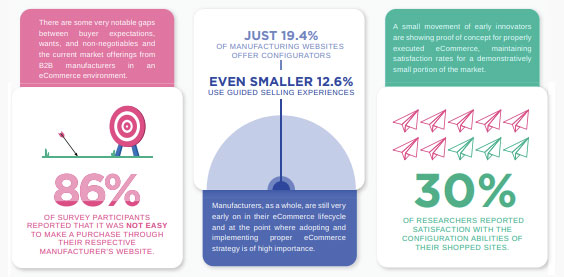Your configurator should be bettering every step of the buying and selling process. Here are the four features that will ensure it does.
By Chris Shutts, CEO, Logik.io
Configure, price, quote (CPQ) software is a critical component to the sales tech stack for manufacturers and amplifies the buying and selling experience when used correctly. CPQ can be a complicated and messy part of your stack, or when architected to meet the needs of today’s consumerized buyers, those who demand experiences that are quick, easy, and consistent, can be a huge point of leverage for your business.
The “price” and “quote” aspects of CPQ are generally more self-explanatory, but it’s the configuration process that can often be a challenge for manufacturers to manage- enabling how buyers can customize, modify, and augment what it is they’re looking to purchase – either directly or with the help of the seller, who is also able to customize during the configuration process – leaving them with a totally personalized order to submit.

B2B manufacturers need to maximize how they architect their configurator to capture the attention and dollars of consumerized buyers. To do so, they should be using their configurator for:
Transparency is paramount for the consumerized buyer. There are countless options for today’s buyers at the click of a button on their computers and they won’t tolerate having to call for pricing or experiencing long, manual quoting processes. That’s a surefire way to lose business.
Real-time pricing and quoting increase the amount of trust your buyer has throughout their experience. Engaging with pricing upfront streamlines communication, even when a buyer doesn’t need a sales rep. Buyers can find the price point that meets their needs – without worries of sticker shock that lead to abandoned carts.
On the seller’s side, prices can be changed quickly and effortlessly, unlike manual methods where a product must be pulled and re-listed.
One of the first sites to offer 3D visualization was Wayfair, which took a simple concept – envisioning a piece of furniture in your family room, kitchen, etc. – and used augmented reality (AR) to demonstrate a visual representation of the item in your room. Now, nearly every home goods store has followed suit because 3D visualization addresses the issue of buying something online that might be too big or too small for the space you have.
Consumerized B2B buyers want the same. They want to be able to identify different angles of the product and how it will fit in their shop. It allows the buyer to see, feel, and otherwise engage with their selection in a tangible manner.
For sellers, it reduces or eliminates the need for prototypes or samples to be produced and sent to prospective buyers.
Once you’ve put the tools in place to offer a consumerized buying experience for your customers, you’ve added digital complexity to the configuration process. Older CPQ software systems have a hard time generating your Sales BOM and your Manufacturing BOM simultaneously. This can cause two major issues in your quote-to-cash process.
Both challenges have been the norm for years for manufacturers, however, as CPQ and configuration solutions have become more modern and adept to more complex use cases out of the box, manufacturers should seek a configurator that can easily handle both BOMs simultaneously during the quote and order creation process.
In a manufacturing setting, there are often thousands and thousands of options when customizing a product.
Intelligent product recommendation personalizes recommendations based on several factors including purchase history, industry, or declared preferences in the configuration process. It matches items that are put in a shopping cart and makes recommendations for additional purchases. If you go to the Target website and order a toothbrush, you expect to have recommendations for toothpaste, floss, and other dental products. B2B buyers have a far bigger challenge navigating the product selection process when it includes thousands of different options, and therefore the demands on their configurator are higher as well.
The ability to leverage your configurator not only as a “compatibility checker” (which many product-based configurators are) but, instead, as a tool that captures customer requirements and needs and matches them to best-fit products and product variations is what becomes truly powerful. Leveraging an attribute-based configurator helps to facilitate this type of experience, and allows B2B manufacturers to provide a truly differentiated experience for their sellers and buyers.
We’ve all experienced a poor user experience when buying a product. It’s frustrating, disheartening, and often the last time you’ll frequent that seller. A streamlined configuration process reduces errors, increases efficiency, and leads to an improved customer experience.
When considering how to upend those complex configuration processes to stay competitive, innovations like real-time pricing and quoting, 3D product visualizers, concurrent BOM generation, and intelligent product recommendation can help you exceed customer expectations. The result? A stronger brand, one renowned for its customer experience, that has long-term sustainable sales.

Chris Shutts is CEO of Logik.io. He co-founded BigMachines in 2000 and sold the company to Oracle in 2013. Chris has a Bachelors and Masters in Mechanical Engineering from MIT and two mechanical design patents.
Scott Ellyson, CEO of East West Manufacturing, brings decades of global manufacturing and supply chain leadership to the conversation. In this episode, he shares practical insights on scaling operations, navigating complexity, and building resilient manufacturing networks in an increasingly connected world.